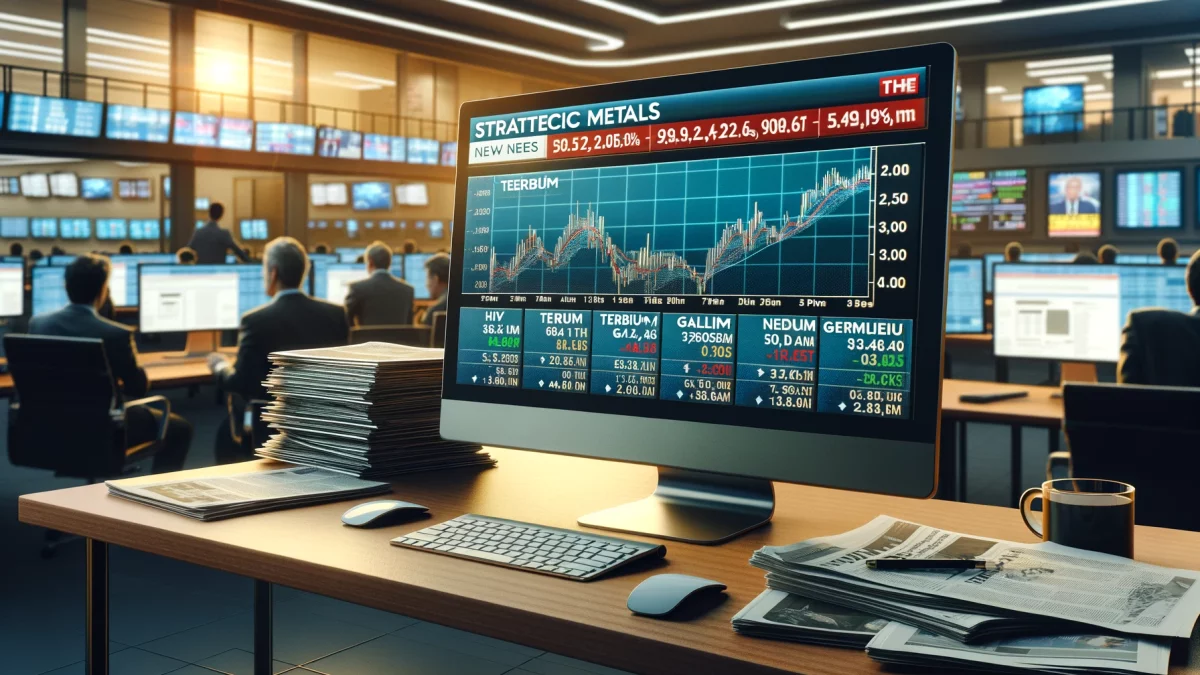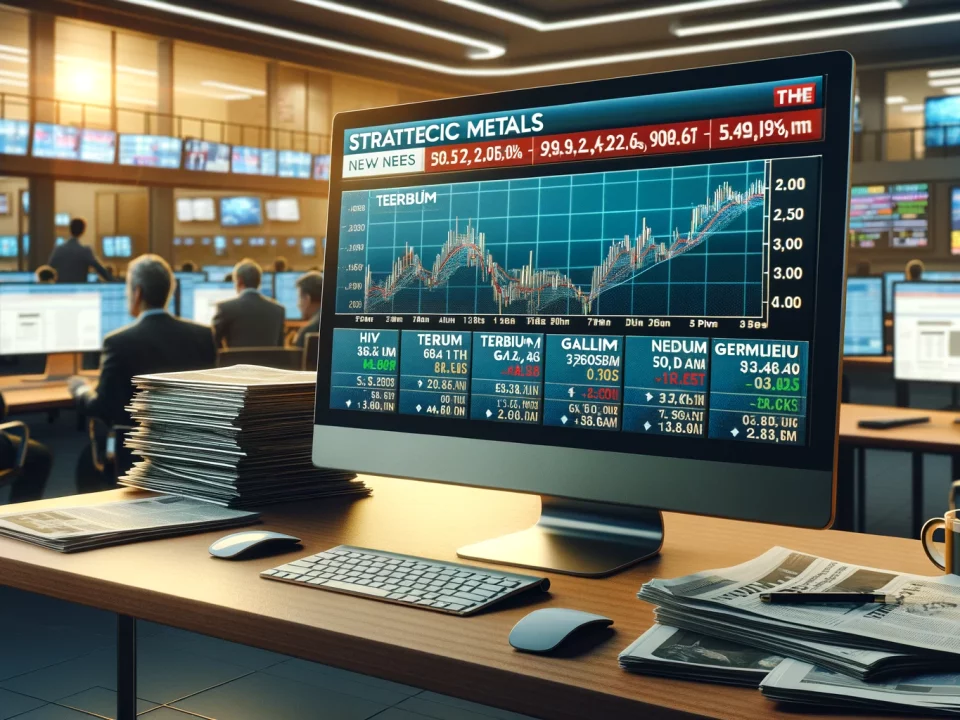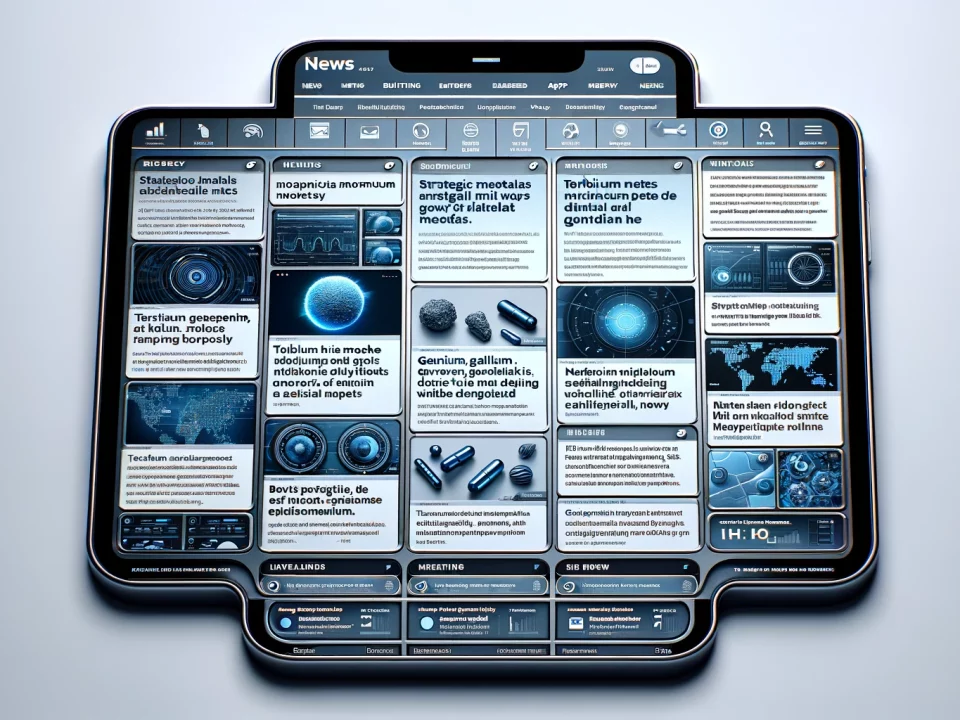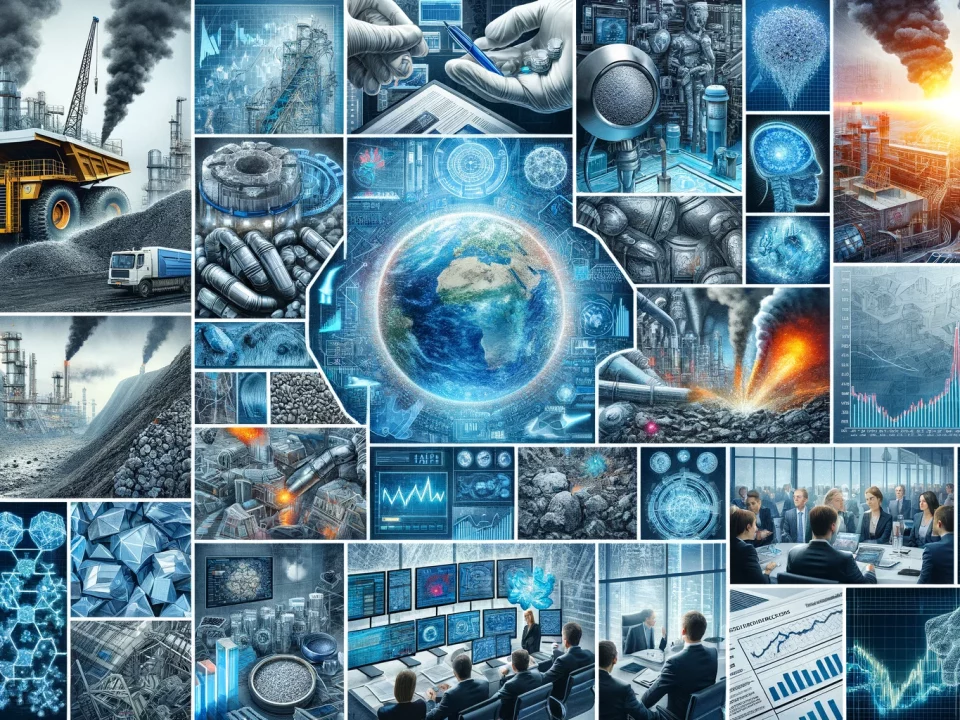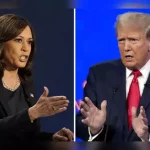
Strategic Metals Market Insight: The 2024 US Election Impact
September 11, 2024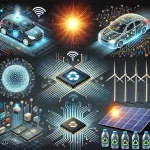
The Rise of Germanium: A Critical Metal Driving Tech and Investment Growth
September 20, 2024Welcome to our weekly news review.
US DEPARTMENT OF C0MMERCE CREATES NEW TOOL TO MONITOR SUPPLY CHAIN RISK:
The tool is set to help the U.S. government identify and address potential challenges.
The United States Department of Commerce’s Supply Chain Center has launched a new tool—SCALE—to monitor and address risks to supply chains. The tool was unveiled at this week’s inaugural Supply Chain Summit, hosted by the Department in collaboration with the Council on Foreign Relations (CFR).
According to the Department of Commerce, SCALE utilizes a set of indicators to determine and evaluate structural risks to the overall U.S. economy across supply chains. Together with input from the Industry & Analysis unit within the International Trade Administration, the tool will support the U.S. government in addressing challenges and problems within supply chains, the Department clarified. The goal is to paint a picture of the U.S. economy to see where it is vulnerable and how to fix it. However, the accompanying fact sheet did not reveal detailed information on what indicators or data the tool uses besides comparing risks across industries and possible reasons for them. The Industry & Analysis unit is set to launch a competition to develop new data and analytics that could support and expand the indicators SCALE uses.
Over Half of U.S. Companies Require Half a Year to Return to Normal Capacity in Case of One Week of Transport Disruption:
In an interview with the Financial Times, Gina Raimondo, Secretary of Commerce, highlighted that data indicates that 57 percent of American industries require half a year to return to average capacity should there be just one week of transport disruption. She added that “plenty” of risks are yet to be understood and addressed.
Critical minerals are one of the most striking supply chain risks to the U.S. economy. Many are used in high-tech fields such as data centers, electric vehicles, or electronics. However, in many cases, the U.S. depends heavily on imports, especially from China, for example, in the case of rare earths or gallium and germanium. While voices in the U.S. are growing louder to decouple from the People’s Republic, Secretary of the Treasury Janet Yellen had said earlier this year that the U.S. would not seek to decouple but to diversify. Consultancies Roland Berger and PwC have also identified raw material supply chains as potential hurdles towards global energy transition efforts and economic prosperity.
US DEPARTMENT OF DEFENCE INVESTS IN TERBIUM PRODUCER:
Rare Earth Salts plans to produce terbium oxide from recycled fluorescent light bulbs.
The U.S. Department of Defence announced Monday that it will award Rare Earth Salts $4.22 million to develop and expand the production of terbium oxide from recycled fluorescent light bulbs. The funding is made via the Defense Production Act Investment (DPAI) office, which has recently administered multiple awards to North American companies focusing on supply chains, such as a cobalt producer in Canada (we reported). By ramping up the domestic production of critical raw materials, these investments align with one of the National Defense Industrial Strategy’s four priorities: bolstering supply chain resilience.
Terbium’s primary use today is as an additive to rare earth permanent magnets to make them more heat-resistant and increase stability. It is a crucial ingredient in high-tech applications, as these magnets are used in various technologies, such as electric vehicles or wind turbines. As a so-called heavy rare earth, terbium is one of the scarcest rare earth elements. China dominates the global production of heavy rare earths, with feedstock from neighboring Myanmar.
Discarded Fluorescent Light Bulbs – A Forgotten Source of Rare Earths Perhaps?
Fluorescent lightbulbs are coated with a phosphor-based coating containing terbium and other rare earth elements on the inside. In recent decades, many fluorescent light bulbs have been discarded in favor of light-emitting diodes (LEDs). Recovering these critical raw materials from waste streams could thus become a relevant new source of supply, as multiple studies allege. Securing alternative sources of supply could help reduce import dependencies from China.
According to Rare Earth, the company has also developed commercial processes to produce other rare earth elements. However, the company needed to clarify the capacity of how many light bulbs it plans to recycle or how much terbium it estimates to produce.
CHINA: NO INCREASE IN EXPORT OF RARE EARTHS YEAR ON YEAR REPORTED:
According to data from the customs authority, the export of rare earths from China in August remained roughly at the same level as last year, with 4,723 tons. However, there was a decline of about four percent compared to July.
China has announced new regulations for its rare earth industry starting in October 2024, but the impact on exports still needs to be determined. Unlike the cases of gallium and germanium, where exports surged shortly after the announcement of export restrictions, a similar trend has not yet emerged for rare earths.
Meanwhile, according to Reuters, the country’s foreign trade presents a mixed picture: while exports grew more than expected, imports fell short of expectations.
GERMANYS INDUSTRY NEEDS $1.4 TRILLION:
The Federation of German Industries (BDI) warns of deindustrialization and calls for ‘bold’ measures. Secure energy and raw material supply is essential.
Bad times for Germany’s industrial sector: According to the Federation of German Industries (BDI), nearly one-fifth of domestic industrial value creation is at risk. Deindustrialization is a real threat, according to a study commissioned by the BDI from Boston Consulting Group (BCG) and the Institute of the German Economy (IW).
The report identifies numerous challenges, including high energy costs and other cost disadvantages, such as taxes, geopolitical factors, and internal crises, like a shortage of skilled workers and increasing bureaucracy. Considering this “poly-crisis,” the BDI calls for a “strong industrial policy agenda” and provides 15 recommendations to enhance competitiveness and economic resilience.
The report details possible policy levers and necessary investments to modernize infrastructure, advance digitalization, and boost demand for green technologies, among other things. Additional private and public investments of 1.4 trillion euros will be needed by 2030.
Critical Raw Material Supply Is Central:
A competitive energy supply is the most urgent task, requiring over 400 billion euros alone. The report also frequently addresses the supply of critical raw materials like rare earths and cobalt, which are crucial in many green and digital technologies. The BDI advocates for strategic import partnerships and expanding German and European raw material extraction and processing to reduce critical dependencies and avoid new ones.
The BDI calls for the implementation of the planned German raw materials fund and a similar fund at the EU level. Improving societal acceptance is also essential, especially for mining projects.
Additionally, the federation suggests increasing material efficiency, strengthening the circular economy, and improving conditions for storing critical raw materials and intermediate products.
CANADA TO INVESTIGATE FURTHER TARIFFS ON CHINESE STRATEGIC METALS PRODUCTS SUCH AS SEMICONDUCTORS AND BATTERIES:
The Canadian government announced Tuesday that it would probe a potential surtax on Chinese critical mineral products, batteries and parts, solar products, and semiconductors. In a statement, the Department of Finance announced a 30-day consultation on possible measures and the timing of the actual implementation.
It justified the move by referring to “unfair competition from Chinese producers” that would threaten Canada’s economic prosperity. The Department added that the measures would build upon those announced last month. The Canadian government said it would implement import tariffs on Chinese-made electric vehicles, steel, and aluminum starting in October (we reported).
The Chinese government responded with a one-year anti-dumping probe on Canadian rapeseed that began Monday amid growing trade tensions between the People’s Republic and Western countries.
In May, the United States published a list of tariffs targeting various Chinese-made high-tech goods. In addition to EVs, steel, and aluminum, the U.S. also targeted batteries, critical minerals, magnets, and other products. The surtax on Steel, Aluminum, and EVs Canada announced last month matched those imposed by the U.S.
AUSTRALIA: NATIONAL MISSION TO BOOST STRATEGIC METALS SECTOR:
Resource Minister highlights the importance of the industry for Australia but acknowledges the need for international partnerships.
Australia’s Resource Minister Madeleine King urges foreign partners to “lean in” to boost the critical mineral and rare earth sectors of Down Under. Speaking at Minerals Week 2024 in Canberra, King emphasized that she believes it is a “national mission” to support these sectors and compared it to Australia’s iron and steel industries, which received significant governmental support in the past. However, she acknowledged that international cooperation with like-minded partners is crucial for the successful development of the sectors.
According to King, the government under President Anthony Albanese has made substantial commitments to the industry in the past, for example, through the Future Made in Australia Act, which seeks to strengthen domestic manufacturing and promote key industries such as critical minerals and clean energy through public and private sector funding. However, King added, the success of the critical minerals and rare earth sectors would also depend on long-term investments from abroad.
EU Ambassador Strikes Similar Note:
Speaking at the same conference, EU Ambassador to Australia Gabriele Visentin struck a similar note. According to Reuters, Visentin highlighted the importance of Australia’s resources for global supply chain diversification efforts. He emphasized that the bloc has already invested substantial amounts into the critical mineral sector of Down Under, adding that the EU is willing to invest more in Australia and other like-minded partners.
Australia and the EU have been in talks to reach a free trade agreement since 2018. However, a deal has yet to be reached. However, the two parties signed a Memorandum of Understanding earlier this year to boost cooperation on critical minerals (we reported).
In addition, Australia has signed agreements on critical minerals with multiple other nations, such as South Korea and the United States. Multiple critical mineral projects in Australia have attracted foreign investment, such as Arafura’s Nolan’s rare earth project.
USA INVESTIGATES HOW CAN THE SEPARATION OF RARE EARTHS BE ACCELERATED:
A research team discovers methods to make standard separation methods faster and cleaner.
Rare earth elements are critical components for numerous high-tech applications. However, before they can be processed into magnets for wind turbines or electric vehicles, the 17 chemically very similar elements of the raw material group—divided into heavy and light representatives—must undergo an elaborate separation process. China has dominated this process for decades. Other countries are exploring new and sometimes more environmentally friendly separation methods to make their supply chains more independent.
Researchers at the Oak Ridge National Laboratory (ORNL), part of the U.S. Department of Energy, have developed one such approach. Their study, conducted in collaboration with Vanderbilt University in Tennessee, could improve standard industrial separation processes.
To isolate a specific metal from solutions of rare earth minerals, ligands are used—chemical substances that selectively bind to individual elements in the solution. According to the ORNL report, the best current separation processes are done step by step, from heavy to light or vice versa. This process is time-consuming and costly and generates much waste, making it less environmentally friendly.
Through their investigations, the scientists reportedly discovered something unique: a ligand resembling the previously used compounds but behaves differently depending on experimental conditions. Depending on the solution’s acidity and the time involved, the ligand binds to different rare earths, both heavy and light. In typical separation systems, ligands are usually specific to just one of these subgroups, explains co-lead researcher Santa Jansone-Popova from ORNL.
The critical insight is that the same compound could be used for multiple separation processes, reducing the necessary steps and making the entire method faster and cleaner. Additionally, the order of separation could be adjusted as needed.
Now that this phenomenon is known, further research could also discover more compounds with similar behavior, according to the ORNL. It is not the first time the facility has worked on rare earth elements. A team involving Jansone-Popova had previously licensed a separation process to an industrial chemical manufacturer.
INDIA AND THE UNITED ARAB EMIRATES TO COOPERATE IN STRATEGIC METALS:
Both countries are expanding their reach for mineral resources on an international scale.
India and the United Arab Emirates (UAE) aim to cooperate more closely in securing critical raw materials. On Tuesday, a Memorandum of Understanding (MoU) was signed between the UAE’s International Resources Holding and an Indian consortium. According to a statement from International Resources Holding, the specific goals include identifying, acquiring, and developing projects for critical minerals globally, including in India.
The company focuses on African countries, extracting and processing copper, cobalt, and lithium. However, the UAE also has an interest in Australia’s mineral resources. A free trade agreement could facilitate investments in the Australian mining sector, which may be finalized later this year (we reported).
India is also pursuing such an agreement with Australia while simultaneously looking into resource deposits in regions like South America.
UN PUBLISHES GUIDE TO GLOBAL ENERGY TRANSITION:
Seven guiding principles and five recommendations, including traceability of critical minerals.
The United States Panel on Critical Energy Transition Minerals published a report on Wednesday, providing fundamental principles and recommendations for pursuing the global energy transition with “equity, justice, and sustainability.” The principles range from protecting human rights and conserving the environment to increased peace and security efforts.
To complement these efforts, the panel recommends establishing an expert advisory group and a system to trace critical minerals along the entire value chain, from mining to recycling.
In addition, the report advises launching a global mining legacy fund to tackle challenges related to abandoned mines and facilitate rehabilitation.
In April, UN Secretary-General António Guterres appointed the panel to respond to a “normative gap” regarding critical minerals and calls from developing countries for guidance on the topic (we reported). The panel comprises nearly 100 developed and developing Governments and includes most of the world’s biggest critical mineral producers, including Australia, China, the Democratic Republic of Congo, and Indonesia.
It also includes many of the world’s top consumers of critical minerals, such as the United States and the European Union. At its launch, Guterres stated that climate efforts “cannot trample over the poor.”
GM AND HYUNDAI JOIN FORCES ON CLEAN ENERGY TECHNOLOGIES:
Memorandum of Understanding to explore future collaboration across critical areas along the vehicle value chain.
Carmakers General Motors and Hyundai have signed a Memorandum of Understanding (MoU) to explore strategic collaboration across a wide field along the vehicle value chain. Potential partnerships include the co-development and production of passenger and commercial vehicles, internal combustion engines, and clean-energy technologies. In addition, the two companies will review opportunities for joint sourcing of steel and raw materials for battery production.
Hyundai Executive Chairman Euisun Chung and GM CEO Mary Barra signed the agreement. “GM and Hyundai have complementary strengths and talented teams. Our goal is to unlock the scale and creativity of both companies to deliver even more competitive vehicles to customers faster and more efficiently,” Barra said in a joint statement.
Hyundai and General Motors are among the world’s largest vehicle producers, third and fifth in sold vehicles in 2023, respectively. According to an automotive engineering professor in an interview with the Korea Herald, a collaboration between large players in the field would have “many implications for the U.S. EV industry. “
Besides future cooperation, the two carmakers continuously seek to secure new sources of supply, primarily to fuel their electric vehicle value chain. Hyundai, for example, has secured the supply of rare earths for itself and its subsidiary Kia from Australian mining company Arafura (we reported). On the other hand, GM has signed an agreement with magnet maker VAC regarding the supply of rare earth magnets.
US FINALIZES LIST OF TARIFFS ON CHINESE GOODS: INCLUDES INDIUM AND TUNGSTEN –
Most of the tariffs announced in May were upheld, and others were updated.
The Office of the United States Trade Representative (USTR) has published the final list of goods that will soon be subject to import tariffs if they originate from China. The USTR upheld most of the proposed $18 billion products the Biden Administration announced in May but made some notable updates. In the original announcement, a surtax of 25 percent was proposed to the umbrella term critical minerals. This has now been clarified to extend to tantalum, tungsten, chromium, indium, and zinc products.
In addition, ores of cobalt and magnesium will also be subject to a 25 percent levy from September 27. The rate on permanent magnets has been upheld at 25 percent starting in 2026, despite the USTR receiving comments about their limited availability, according to the agency. The much-discussed levy on Chinese-made electric vehicles of 100 percent has also been upheld.



